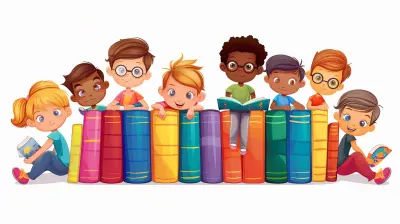23 March 2025
Reading aloud to your child is one of the best ways to nurture their love for books. But what if you could make storytime even more special? Imagine turning every reading session into an adventure—a moment filled with excitement, creativity, and learning.
If you're looking for ways to make reading more engaging, you've come to the right place! In this article, we'll dive into fun and interactive storytime activities that will boost your child's imagination, enhance comprehension, and make books even more magical. 
Why Interactive Storytime Matters
Reading is more than just decoding words—it's about understanding, engaging, and connecting with stories. When kids actively participate in reading, they retain information better and develop a deeper love for books.By adding hands-on activities, you're:
- Boosting comprehension skills
- Strengthening creativity and imagination
- Encouraging a love for storytelling
- Enhancing vocabulary and communication skills
- Creating special bonding moments
Now, let’s jump into some creative storytime activities that'll transform the way your child experiences books. 
1. Bring Characters to Life with Voices and Expressions
Reading in a monotone voice can make even the most exciting tales feel dull. Instead, add some drama!- Use different voices for each character—high-pitched for fairies, deep and gruff for giants
- Add emotion to your tone—whisper for suspense, shout for excitement
- Use facial expressions to reflect what’s happening in the story
This small change makes storytelling far more engaging and helps kids visualize the characters and emotions in the book.
Bonus Tip: Let your child take over and voice the characters too!

2. Act It Out with Role-Playing
Why just read a story when you can live it? Role-playing brings books to life and lets your child step into their favorite characters’ shoes.- After reading a page, act it out together
- Use household items as props (a spoon as a wand, a blanket as a cape)
- Let your child take the lead in re-enacting scenes
Acting out stories helps kids absorb details, remember vocabulary, and develop confidence in expressing themselves. 
3. Create a DIY Storybook Theater
Turn your living room into a mini theater and put on a show!How to Set It Up:
- Pick a favorite book and assign roles (you and your child can each play different characters)- Use puppets, stuffed animals, or finger puppets as actors
- Set up a simple stage using a curtain or blanket
This makes reading feel less like a "task" and more like an exciting performance. They’ll associate books with fun—and that’s a big win!
4. Predict the Next Chapter
Before turning the page, ask your child:"What do you think will happen next?"
Encouraging predictions keeps them engaged and teaches critical thinking. Whether they guess correctly or not, their minds are actively processing the story.
For an extra twist, write down their predictions and revisit them at the end of the book to see how close they were!
5. Make Your Own Illustrations
Not all books have pictures, and that’s a great opportunity for creativity!- Read a short passage and ask your child to draw what they imagine
- After finishing a book, have them create their own cover design
- If the story includes new words, illustrate them together to reinforce meaning
Visualizing what they’re reading strengthens comprehension skills—and who knows, you might have a future illustrator in the making!
6. Add Sound Effects for Extra Fun
Boom! Crash! Whoosh!Sound effects make stories jump off the page. Encourage your child to help with sounds:
- Clap for thunder
- Rustle paper for leaves blowing in the wind
- Stomp feet for giant footsteps
This sensory involvement creates a multi-dimensional reading experience that keeps kids engaged from start to finish.
7. Use Sensory Play for Storytelling
Kids learn best when they engage their senses. Enhance their reading experience with sensory play:- Texture Fun: If reading a book about the ocean, let them touch sand or seashells
- Food Connection: Reading Goldilocks and the Three Bears? Make oatmeal and decide which bowl is "just right"
- Scent Play: Reading about a garden? Let them smell flowers or herbs
These small actions make stories feel real, helping kids form deeper connections with what they read.
8. Create a Story Bag
A story bag is like a treasure chest filled with items related to the book.How to Make One:
- Pick a book- Find small objects that relate to the story (a toy plane for an adventure book, a crown for a fairy tale)
- Let your child pull out items as you read to enhance engagement
This hands-on approach turns a regular reading session into a fun, immersive activity.
9. Let Them Retell the Story in Their Own Words
After finishing a book, ask your child to retell the story in their own words. You can even record them as they narrate it!- This strengthens comprehension
- Helps them practice sequencing events
- Encourages storytelling skills
For younger kids, you can guide them with prompts like:
- What happened first?
- What did the character do next?
10. Turn Storytime into a Craft Activity
A great way to extend the magic of reading is through crafts!Some fun story-based craft ideas:
- Paper Puppets: Make characters from the book using paper and markers
- Story Stones: Paint small rocks with scenes from the story
- DIY Bookmark: Create a bookmark inspired by the book’s theme
Crafting reinforces the story in a hands-on way, and kids love showing off their creations!
11. Make Reading a Special Event
Turn storytime into an exciting daily tradition.- Create a reading nook with comfy pillows and fairy lights
- Have themed reading nights (pajama night, flashlight reading, outdoor reading under the stars)
- Celebrate finishing a book with a "story award" (a homemade certificate or sticker)
Making reading feel special builds positive associations with books and encourages lifelong readers.
12. Encourage Storytelling Beyond Books
Reading isn’t the only way to develop storytelling skills. Let your child create their own stories!- Give them three random objects and ask them to build a story around them
- Make a “story jar” filled with fun plot ideas they can pick from
- Let them design and “publish” their own mini-book
Encouraging storytelling sparks imagination and shows kids that they can be storytellers too!
Final Thoughts
Making storytime interactive doesn’t just enhance your child's reading experience—it creates memories that last a lifetime. By using simple yet engaging activities, you’ll turn books into magical adventures they’ll never forget.So, next time you grab a storybook, add a little extra flair—act it out, make sound effects, or whip up a themed snack. Your child will thank you with endless giggles and a growing love for reading!
Happy reading!







Daisy Pruitt
Loved this article! Storytime can be such a magical experience for kids. These activities are perfect for making reading even more fun and engaging. Can’t wait to try some of these with my little ones!
April 1, 2025 at 3:30 PM